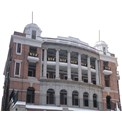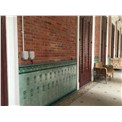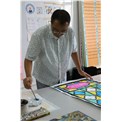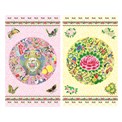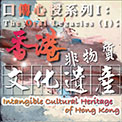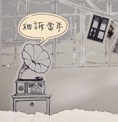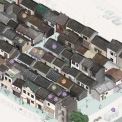 Collections
Collections Hi! Houses: A Journey into the History of Century-old Houses with the Artists
Hi! Houses: A Journey into the History of Century-old Houses with the Artists Wilson Shieh x Dr Sun Yat-sen Museum
Wilson Shieh x Dr Sun Yat-sen Museum Colouring the Revolution: Chromatic Vibrancy of Wilson Shieh in Kom Tong Hall
Colouring the Revolution: Chromatic Vibrancy of Wilson Shieh in Kom Tong Hall
A historical building, a sentimental quest
A sense of déjà vu struck Wilson Shieh when he set foot in the hundred-year-old Kom Tong Hall for the first time. It came from his memory of King’s College, his alma mater, which is also a historical building from the colonial period. The red bricks, columns, windows and balconies are all very similar to his old campus, only Kom Tong Hall is grander and more resplendent. He remembered his favourite pastime was to slide across the red tiles in his black leather shoes and compete with his classmates to see who could slide the farthest distance. “The slippery tiles were like these - we could slide along them like we were wearing Heelys,” he said with a laugh.
Shieh recalled that before the mansion was converted into the Dr Sun Yat-sen Museum, it was once a church, and the baptismal font is still there. But it was only after he had taken on this project that Shieh began to look for traces left by its original owner, Ho Kom-tong. Although the mansion was once a family home, Shieh found it rather unfamiliar because its White Hall, the main reception room where Ho used to receive guests and hold cocktail parties, is too grand to be associated with the ‘living room’ of the ordinary folks. In fact, although this hundred-year-old building has been refurbished and restored to its original state, one would still have to rely on clues and imagination in order to reconstruct the family scenes of the Ho clan. On the balcony on the first floor, he noted that the tiles on the wall differ from the classical style of the building, with the ducklings suggesting that this floor was once the children’s residence. The patterns on the tiles on the main floor feature Southeast Asian characteristics, which lead Shieh, who has an avid interest in colonial history, to conclude that this is likely the result of cultural fusion from different eras.
Tracing hidden cultural symbols
Although the current exhibition hall is filled with exhibits related to Dr Sun Yat-sen, Shieh can see slices of everyday life of the Ho family in the corners here and there like slides from a projector. Both Ho Kom-tong and Dr Sun were born in 1866, and both went to the Central School for Boys (the present Queen’s College) and left in 1886. As contemporaries, both were under the influence of Eastern and Western cultures; both were patriotic, and had illustrious stories to tell. In the end, Shieh decided to base his creative endeavour in this old house around Dr Sun’s history. He believes that Dr Sun’s life greatly reflects the lives of a certain group of Chinese people of the time. Quite a number of them wanted to bring back their foreign knowledge and experiences to China after they had received a Western-style education. The celebrated family of Robert Ho Tung was also one of the leading figures of the times. Dr Sun’s revolutionary ideas first germinated in Hong Kong. He also visited many places in the subsequent pursuit to realise them, so he would have had many stories of East-West cultural fusion to tell. Shieh wanted to study the seven important stages in Dr Sun Yat-sen’s life and glean from the places Dr Sun visited – Guangdong in the late Qing Dynasty, Hawaii, Hong Kong, Macau, Japan, Singapore, Malaysia and China in the early Republican days – searching for distinguishable artistic elements, architectural styles and trends of the times. He translated them into historical motifs that he could fuse into his paintings. It was an attempt to approach ‘serious’ history from a more humanistic angle.
A fresh creative attempt, but also a challenge
Creating a work of art in a historical building is something Shieh has never attempted before. Different from a white cube, the walls, columns and architectural decorations of the Dr Sun Yat-sen Museum belong to a unique period and style, and it did not prove easy to create an art project that could blend all seamlessly. As this museum was once a mansion integrated with Chinese and Western architectural features, Shieh thought that screens would create a domestic ambiance without the risk of damaging the structure of the Monument. Another problem to overcome was that Kom Tong Hall in its current incarnation has a rather monotonous colour scheme because of the display of historical archives and artefacts. So Shieh wanted to inject more vivacity into it. His colour choices are all tied to the building’s rich and unique history. Shieh drew inspiration from the Peranakan Museum in Singapore, which was converted from the Old Tao Nan School built in 1912. It documents the history of marriage between Chinese men and local women during the Ming and Qing dynasties, and exhibits the Nyonya culture which is a fusion of Chinese and Malay traditions. “Nyonya costumes are more colourful, yet they feature many Chinese patterns and symbols. The museum uses this characteristic as the general theme for the exhibitions. I could still remember the colourful ambiance long after.” He decided to adopt this approach with his installation at the Dr Sun Yat-sen Museum.
On the screens featuring different characters of Dr Sun Yat-sen, Shieh and his artists’ team endowed stylised figures with various artistic elements, such as ‘Canton enamel’ from the ceramics of Tongzhi era of the Qing Dynasty (late 19th to early 20th centuries), Hawaiian folk paintings from the 19th century, pattern of wallpaper and Hong Kong college architectural styles of the Victorian period, Portuguese blue and white porcelain from Macau, ukiyo-e from the Meiji era of Japan (1868-1912), the colours of Straits-born Chinese in Malaysia and Singapore, and artistic elements from the early Republican period. He hopes to trace the footsteps of Dr Sun Yat-sen throughout his life via these richly-coloured cultural motifs, reviewing the revolutionary history in today’s context.
The canvas of history may fade with time, but for Kom Tong Hall, although it has changed hands several times and borne witness to the changing relationship between Hong Kong and modern China, its corridors, columns, windows and balconies have retained their lustre, and still emit a radiant glow representative of the fusion between East and West. The subtle and brilliant images of Dr Sun Yat-sen painted by Shieh are a colourful rendition of this hundred-year-old residence which brings together the various slices of its richly storied history.
